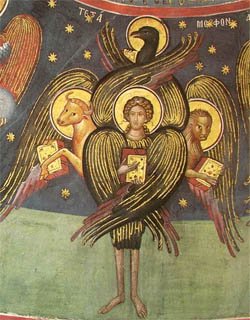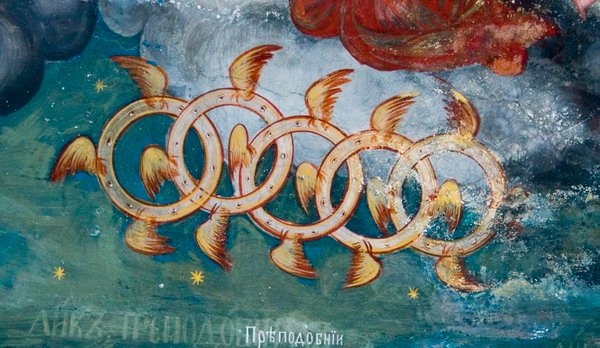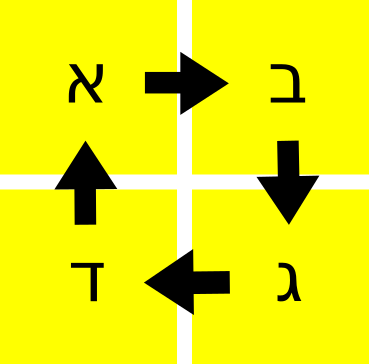How many angels can, in fact, dance on the head of a pin?
There is a common myth that the question, "How many angels can dance on the head of a pin?" was some critical if pointless point of contention between theologians. In truth, there was no mention of this idea until hundreds of years after these alleged debates actually took place. There did exist question-and-answer sessions called Quodlibeta when theologians did debate absurd questions (such as, is a man with two heads baptised once or twice?) but these were never defining moments of theological controversy. The theological equivilant of xkcd's What If? column, if you will.
Yet the question, absurd or not, remains.
Theologians have written about angels in detail. Meanwhile, our knowledge of the physical universe has also increased that maybe, just maybe, we can find out the answer FOR ALL TIME (or at least for the time being.)

Solve for X.
A disclaimer.
I'm just a dude on the internet, not a theologian or physicist. It's quite possible I've got some stuff wrong. Bear with me here, yo?
So we can get to the actual topic
The first objection, that there is no God and therefore no angels, would take too long to argue through here. If you're an atheist or agnostic, consider this a fun romp through someone else's ideas.
The second objection, that an omnipotent God would have no need to create angels would also take too long. Just roll with it, OK?
Do angels have physical bodies in order to dance?
Angels do not have bodies. They are pure spirits--a mind, or a kind of ideal, if you will. Nonetheless, as our imaginations are bodily, we can only picture angels as having the same. Thus, in every part of the Bible, angels, and even God, is described bodily. Religious art has continued the practice, usually emphasizing the symbolism.

This cherub has the faces of a human, a lion, an ox, and an eagle, representing the wisest, noblest, strongest and swiftest being in all creation. These four aspects, called the Tetramorph are usually used to describe the four evangelists, which is why this dude(s?) is holding four books. (Fresco from Meteora, Wikimedia Commons)
If we go by the appearances of angels in the Bible, the answer may be "one." The plague-bearing angel described in Kings and Chronicles is described as stretching between Heaven and Earth, with his sword over Jerusalem (and freaks David out). In Revelations, another angel is described as standing on both the land and the sea, as well as having pillars of fire for legs.
Or, in my favorite two sections of the Bible, God's heavenly chariot is described as borne by four cherubim, each with four faces and four wings and completely covered with eyes (and freaks Ezekiel out). They are described as going straight in every direction without turning, which would preclude many dances. Each cherub is also accompanied by a wheel within a wheel, also covered by eyes. (Let me tell you, God has some sick rims.) These wheels, traditionally considered thrones (sometimes called ophanim), are described as "so high they were dreadful" (KJV) and also go in straight lines without veering.
For that matter, have you ever seen a wheel dance?

I guess you can spin, guys? (John the Baptist Church, Kratovo, Macedona, from Wikimedia Commons)
But let's get back to the pure minds. If we insist that a dance must be bodily, then the answer is zero. But angels do apparently bodily things, such as hand out edible scrolls and announce the birth of Jesus, or even physical things such as setting bushes on fire or killing 185,000 Assyrians in a single night. (That part is usually not depicted on greeting cards.) Dancing, or some activity analogous to it, seems quite reasonable. Or, for that matter, appearing to dance, therefore revealing some aspect of God. Seems legit.
Won't we run out of angels?
There's no way of knowing how many angels are out there, aside from that their number is strictly superior to the human population. (Every human has one guardian angel, and some angels are not guardian angels, ergo there must be more.) For that matter, we don't know how large the "human" population is, since any sapient alien is human in the theological sense.
But for the sake of this argument, let's suppose that God is supplying an unlimited number of angels. I would hesitate to say "infinite", since this brings other questions. (Theologians have asked if it is possible to create an actual infinite, or merely a potential infinite. Let's not go there.) And, we will see, there will be quite a few that can fit.
But couldn't you actually fit an infinite number of angels on a pin? They don't have bodies.
Take, for the moment, the concept that angels are pure minds. Without the necessity of any brain to process, there is no time between when they start a thought and reach its conclusion, or the conclusion and the action desired. Indeed, the descriptions of wheels, wings, and swords are mere descriptions of this invisible angelic nature. Pseudo-Dionysus the Areophagite writes that the wheels represent this straight direction of thought without delay or turning. (Other writers have offered other explanations for the wheels, including Milton's poetic image of them shooting lightning bolts out of the eyes.)
Thomas Aquinas writes that every angel is distinguished by its office. If two angels can act in the same place at the same time, how do we know there is actually two angels, and not simply one? As such, there must be no angel collisions--each spot in the universe may have only angel working in it, dancing or otherwise.
What counts as a separate spot?
God can, obviously, determine the position of angels at any level of precision. If this is the case, then the answer is unlimited--God can always squeeze another angel in.
But I am going to stretch things a little and say the limit is what humans can distinguish. LOLWUT? It's far from unprecedented. The official determination of whether a liquid is suitable for baptism is not whether it is clean, or dirty, or natural, or unnatural or blessed, or unblessed, but whether a human being can reasonably call it water. (Similarly, what counts as bread and wine.)
If this still seems strange to you, consider that human beings are made in the image of God, and in that way share some divine attributes. In a way that, say, thermometers and other gadgets are not--and yet those, too, were made by human hands, and have no meaning on their own except as we interpret their information. We use our own minds to distinguish whether we are in this reality or only a dream--so applying this same ability of reason to parts of the supernatural world is hardly unreasonable.
How do you see an angel?
Several times in the Bible, angels are only seen by the one they're visiting. Perhaps this is because every time they appear in the Bible, people freak out. (Seriously. Every time.)
Similarly, they are sometimes only heard by one. The wings of the cherubim, for example, sounded "like the roar of rushing waters, like the voice of the Almighty, like the tumult of an army" which would be an awfully big disruption when they're later parked in the Temple courtyard, in addition to being incredibly awkward.
In any case, this implies what one is seeing is the mental image of an otherwise invisible being (or seeing the uncreated light of Heaven with spiritual eyes, etc.) Nonetheless, there is nothing preventing an angel from producing a natural burst of photons.
How far can humans distinguish between points in space?
If angels are manifesting as human-sized or larger we clearly have, once again, just one. But being that angels can manifest at any size or shape, they could very well appear as microscopic, or well below.
For the sake of the argument, "distinguishing" shall count as potentially distinguishing just one angel. You can distinguish between the pixels on your screen, whether or not you actually perceive over a million individual dots at a time.
If it is how many a bare human eye can distinguish, the angel total is probably in the hundreds. If it's how many a human can distinguish with the best laboratory equipment, then it's far, far, higher.
If it's how many a human could distinguish, even theoretically, we may have an answer. As one decreases the size of the wavelength of a photon, its frequency (and therefore energy) also increases. Beyond a certain point (one Planck length) the photon would collapse into a miniature black hole. But just at that point, one could still distinguish where specifically the photon came from in a dance floor of angels. Using equipment, of course--that one photon would have about the energy of three tons of TNT!
Humanly, it'd be nowhere near possible to create such a photon, but it would be no more trouble to angel than creating any other photon.
(Aside: Some physical theories have that there is some kind of universal boundary at or nearby the Planck length, but being not even a layman in the subject, I can hardly comment on that.)
The good news is that there is an estimate for the actual length of a Planck length, which means, yes, yes, WE CAN DO THE MATH!!!
Let's start counting!
The most space-efficient dance.
What exactly counts as dance is beyond the scope of this article. But for the sake of this argument, let us say it is any movement with a regular pattern.
Take a look at this one.

See? You don't even need to turn after all.
Each of the squares is one Planck length by one Planck length. Every beat, the angel at Aleph steps to Beth, and the one at Beth steps to Gimmel, and so on. By "step", of course, I mean that while it was previously acting in Aleph, it now acts in Beth. "Act" is left undefined, as if it involved physical energy a pin's worth would probably turn the pin--and basically everything else--into a massive black hole.
With this dance, we can maximize the angel density of any given physical volume.
The dance floor
Since we're working on the Planck scale, concepts such as a pin having a solid surface are meaningless. For reference, a hydrogen atom is about 3.1×10^24 Planck lengths wide. All but an incomprehensibly tiny inside that is empty space.
Let us suppose a pin with a head one millimeter in diameter. Picture, covering the pin, a disc one Planck length thick. This cylinder is the dance floor. Each 1x1x1 Planck "cube" contains one angel, performing the above dance.
We could fit even more in if we allowed angels to be atop each other, true--but then it'd be angels dancing atop angels dancing atop a pin.
And yes, I'm imagining space is perfectly regular here. It isn't, but at the magnitude of numbers we're working with doesn't really matter.
The estimate
We can find the volume of a cylinder by:
Thicknessx(Pi*radius^2)
One millimeter is 6.187×10^31 Planck lengths in diameter, which we halve to get the radius.
And thus:
1x(Pi*((6.187×10^31)/2)^2)
Which leads to...
3.006x10^63
For reference, there are estimated to be 10^70 atoms in the universe, and there are definitely 2^160 (around 10^48) possible bitcoin addresses.
And there we go! After several potentially arbitrary or incorrect assumptions, all our questions in regards to celestial choreography have been answered!
...
OK, aside from what those wheels are about, but other than that.
The descriptions of angels found in scripture bear a very close resemblance to some imagery I've seen on potent doses of psychedelics.
This is such a large and in depth post for a term I have never heard of lol. If anyone else has not heard of this term this is actually a Wiki page for it https://en.wikipedia.org/wiki/How_many_angels_can_dance_on_the_head_of_a_pin%3F Thanks for the post, very confusing and fun!
Nice post and good explanation of the process of reasoning through the question. It is of course the process of reasoning that was so important to medieval debates. You made a lot of good estimates in the absence of hard data, and quite a few good philosophical observations about the nature of the question being approached from a human point of view.
ColdMonkey mines Gridcoin through generating BOINC computations for science...
Hello, @smithgift, Matthew... I am delighted to have discovered you today. Welcome to Steemit! :)
I have followed you on the strength of this one article alone; I found it amusing, intriguing, enjoyable, thought provoking, multi-dimensional! Thanks!
You have me thinking about everything from theology to logic to finite automata, and more. You've left me smiling. I expect that I will be able to learn much from you. I invite you to visit my blog by clicking on the image below, in the hope that you may also find items of interest there. 😄😇😄

P.S. Here's an attempt of my own to convey the overpowering nature of an appearance of angels:
"'Ampa, Tell Me A Story" - A Shepherd's Christmas Tale
Glad you liked it. :D Hope I can make future posts interesting, too.
I have no doubt... Steem on, my new friend! ;)
nice one
i upvote you please upvote on my post
https://steemit.com/mining/@zeeshan23/worker1-upgrade-pt2-parts-fitting-and-first-power-up